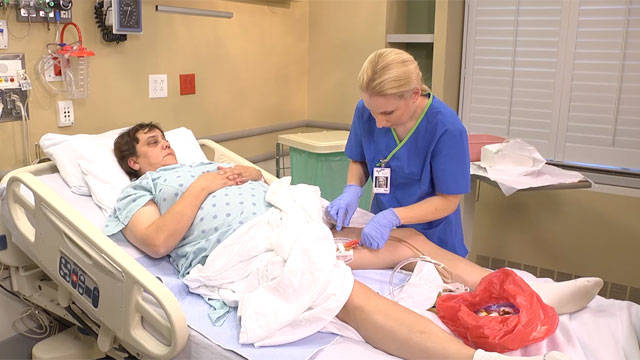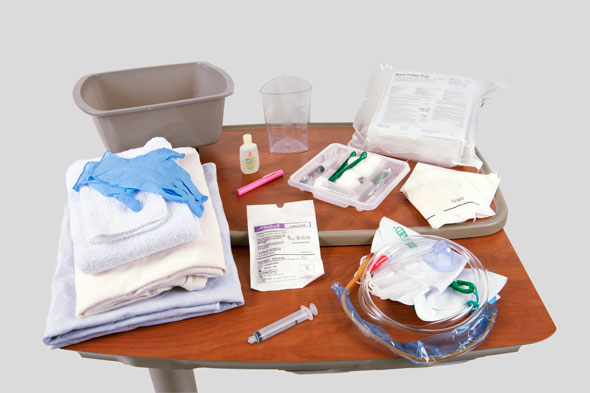Urinary Catheter Management
Select a Skill:
- » Inserting an Indwelling Urinary Catheter in a Female Patient
- » Inserting an Indwelling Urinary Catheter in a Male Patient
- » Irrigating a Urinary Catheter
- » Performing Intermittent Straight Catheterization
- » Obtaining a Specimen from an Indwelling Urinary Catheter
- » Removing an Indwelling Urinary Catheter
- » Caring for a Suprapubic Catheter
Take the Review Test:

Safety
- Implement actions to prevent catheter-associated urinary tract infection (CAUTI), including the following:
- Maintain aseptic technique when catheterizing a patient to prevent CAUTI.
- Limit the use of indwelling catheters to essential conditions, and remove them as soon as medically indicated.
- Use the smallest catheter possible.
- Cleanse the urethral meatus daily with soap and water or perineal cleanser.
- Maintain a closed urinary drainage system.
- Maintain a free flow of urine.
- Avoid trauma by securing the catheter.
- Adequate oral intake is essential for bladder health, especially if the patient has an indwelling urinary catheter.
- Use a nonlatex catheter if the patient is allergic to latex. Assess the patient for an allergy to the antiseptic, tape, and lubricant.
- Use an appropriate-size catheter based upon the patient’s health condition because larger catheter diameters increase the risk for urethral trauma. Always hang the bag below the level of the bladder on the bed frame or a chair so that the urine will drain down and out of the bladder.
- Never allow the bag to touch the floor.
- Always check the manufacturer’s instructions prior to inserting an indwelling catheter for pretesting balloon inflation and amount to be inserted.
- Be aware that if no urine appears when catheterizing a female patient, the catheter may be in the vagina. If this occurs, leave the catheter in the vagina as a landmark indicating where not to insert, and insert another sterile catheter.
- Be sure to inflate the balloon of an indwelling urinary catheter as directed by the manufacturer’s instructions. Indwelling catheter balloons should not be underinflated. Underinflation causes balloon distortion and potential bladder damage.
- If the patient complains of sudden pain during inflation of a catheter balloon or if you feel resistance when inflating the balloon, stop inflating the balloon, allow the fluid from the balloon to flow back into the syringe, advance the catheter farther, and then reinflate the balloon. The balloon may have been inflating in the urethra. If pain continues, remove the catheter and notify the health care provider.
- Be aware that older adults have an increased risk for UTI related to increased prevalence of chronic disease such as diabetes, as well as a higher prevalence of incontinence.
Equipment
(Roll cursor over items to see labels)

Indwelling catheterization kit - contents may vary
- Double-lumen catheter
- Sterile drainage tubing with collection bag
Indwelling catheterization kit - contents may vary
- Fenestrated drape
- Lubricant
- Cleansing solution (or prefilled swabs)
- Cotton balls
- Forceps
- Prefilled syringe for balloon inflation
- Sterile gloves
- Specimen container
Catheter securement device
Penlight (optional)
Bath blanket and waterproof pad
Washcloth and towel
Clean gloves
Basin
Soap
Measuring container for urine
Syringe for drawing urine sample (optional)
Delegation
The skill of inserting an indwelling urinary catheter cannot be delegated to nursing assistive personnel (NAP). Be sure to inform NAP of the following:
- Explain how to assist with patient positioning, focus lighting for the procedure, maintain privacy, empty urine from the collection bag, and assist with perineal care.
- Instruct NAP to report postprocedure patient discomfort or fever.
- Instruct NAP to report abnormal urine color, odor, or amount, or if the catheter is leaking or causing pain.
Preparation
- Review the patient’s medical record, including the health care provider’s order and nurses’ notes. Note previous catheterization, including catheter size, response of the patient, and time of catheterization.
- Review the medical record for any pathological condition that may impair passage of the catheter, such as urethral strictures.
- Ask the patient about allergies, and also check the chart.
- Assess the patient’s weight, level of consciousness, developmental level, ability to cooperate, and mobility.
- Assess the patient’s gender and age.
- Assess the patient’s knowledge, prior experience with catheterization, and feelings about the procedure.
- Assess for pain and bladder fullness. Palpate the bladder over the symphysis pubis, or use a bladder scanner (if available).
- Perform hand hygiene, and apply gloves. Inspect the perineal region, observing for perineal anatomical landmarks, erythema, drainage or discharge, and odor. Remove gloves, and perform hand hygiene.
- Explain the procedure to the patient.
- Arrange for extra personnel to assist as necessary.
Follow-up
- Palpate the patient’s bladder for distention, or use a bladder scan.
- Ask the patient to describe his or her level of comfort.
- Observe the character and amount of urine in the drainage system.
- Determine that there is no urine leaking from the catheter or tubing connections.
Documentation
- Record and report the reason for catheterization; type and size of the catheter inserted; amount of fluid used to inflate the balloon; specimen collection (if applicable); characteristics of the urine; amount of urine; the patient’s response to the procedure; and any education provided to the patient.
- Record the amount of urine on the intake and output (I&O) flow sheet record.
- Report any persistent catheter-related pain and discomfort to the health care provider.
Review Questions
1. Which action would the nurse take to reduce the risk for a catheter-associated urinary tract infection (CAUTI) in a patient with an indwelling urinary catheter?
 Wear clean gloves when inserting the catheter.
Wear clean gloves when inserting the catheter. Inflate the balloon on the catheter before using it.
Inflate the balloon on the catheter before using it. Use the smallest-size catheter possible.
Use the smallest-size catheter possible.  Empty the urine by disconnecting the catheter from the collection bag.
Empty the urine by disconnecting the catheter from the collection bag.
2. Which action(s) would minimize the patient’s risk for injury during insertion of an indwelling urinary catheter?
 Assessing the patient for allergies related to latex, antiseptic, tape, and/or iodine-based substances
Assessing the patient for allergies related to latex, antiseptic, tape, and/or iodine-based substances  Thoroughly cleansing the patient’s perineal area with povidone-iodine solution before inserting the catheter
Thoroughly cleansing the patient’s perineal area with povidone-iodine solution before inserting the catheter  Performing proper hand hygiene and applying gloves before inserting the catheter
Performing proper hand hygiene and applying gloves before inserting the catheter  Terminating the insertion if the patient reports pain at any time during the procedure
Terminating the insertion if the patient reports pain at any time during the procedure
3. Which statement best illustrates the nurse’s understanding of the role of nursing assistive personnel (NAP) when inserting an indwelling urinary catheter in a female patient?
 “Please direct the light to better illuminate the patient’s perineal area.”
“Please direct the light to better illuminate the patient’s perineal area.” “You need to be comfortable inserting a catheter in a patient of her size.”
“You need to be comfortable inserting a catheter in a patient of her size.” “See if a size 14-French catheter is big enough.”
“See if a size 14-French catheter is big enough.” “Find out if the patient has any allergies to latex or iodine.”
“Find out if the patient has any allergies to latex or iodine.”
4. The nurse has completed the initial inspection of the patient’s perineum and is preparing to insert an indwelling urinary catheter. Which action would the nurse complete next?
 Begin to establish a sterile field.
Begin to establish a sterile field. Open and assemble the urine drainage bag.
Open and assemble the urine drainage bag. Remove soiled gloves, and perform hand hygiene.
Remove soiled gloves, and perform hand hygiene. Center the drape over the patient’s labia.
Center the drape over the patient’s labia.
5. A female patient placed in the dorsal recumbent position for the insertion of an indwelling urinary catheter tells the nurse that she “doesn’t feel comfortable in this position” and that her “back really hurts.” What is the nurse’s best response?
 Reassure the patient that the procedure will take only a few minutes.
Reassure the patient that the procedure will take only a few minutes. Promise to reposition the patient as soon as the catheter has been inserted.
Promise to reposition the patient as soon as the catheter has been inserted. Reposition the patient in a side-lying position, with her upper leg flexed at the knee and hip.
Reposition the patient in a side-lying position, with her upper leg flexed at the knee and hip. Explain to the patient that the position will allow the catheter insertion to be more efficient.
Explain to the patient that the position will allow the catheter insertion to be more efficient.
You have completed the Review Questions for this skill. To take the Review again select the Start Over button. To proceed to another skill select from the dropdown menu. Select the Home or Back button to proceed to the next section.

